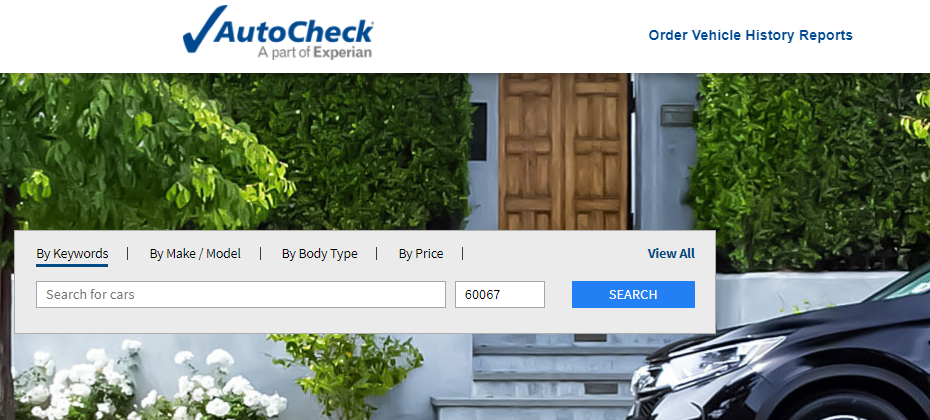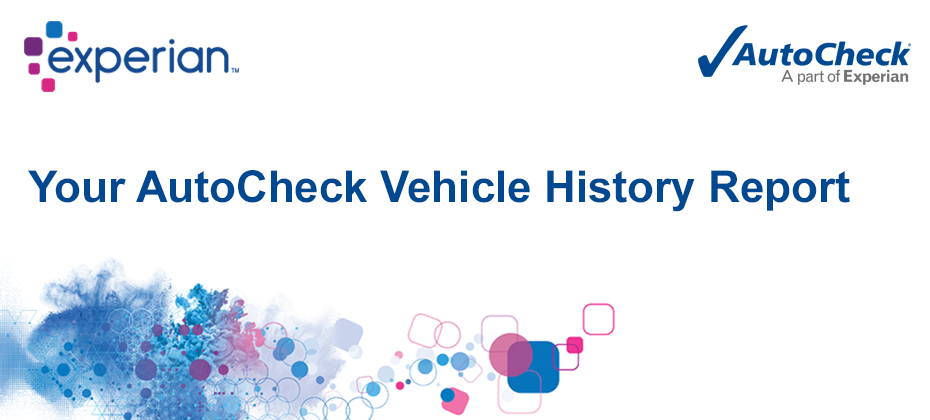Tag: VHR

As more consumers turn to the internet to research and purchase preowned vehicles, dealers have focused marketing efforts to the online marketplace to get their vehicles in front of shoppers. According to Think with Google, 95% of vehicle buyers use digital as a source of information and it takes 65% of buyers just three weeks to research vehicles online prior to purchase. With seventy-eight percent of consumers visiting two or more sites during their shopping “journey”1 how do dealers capture their attention, increase lead and sales conversions? Dealers need to share key data in a vehicle history report such as information related to reported accidents, odometer readings, open recalls, and whether the vehicle qualifies for buyback protection. These details help consumers better understand and make informed decisions when shopping. Case Study: How leveraging the AutoCheck VHR subscription increased lead and sales conversions Our integration partner, CarZing, an online auto shopping portal, offered a Free AutoCheck® Vehicle History Report on their Vehicle Detail Page (VDP) which increased lead and sales conversions. Together, we analyzed six months of lead activity on millions of vehicle listings on CarZing focusing on the 200 most popular vehicles by year/make/model. Key findings indicated that vehicle listings offering a Free AutoCheck VHR on the VDPs achieved a higher lead conversion rate than listings for the same year/make/model for vehicles without a Free AutoCheck report. Here’s a few highlights from the full report: Furthermore, when layering in available sales data, sales conversion is higher for vehicles featuring a free VHR available to consumers than vehicle listings that did not. Based on the results, CarZing’s Director of Operations, Frank Merle strongly encourages all AutoCheck clients take advantage of the exponential value that offering a free AutoCheck report brings to dealership VDPs. Dealers with an AutoCheck subscription can list their vehicles for free on AutoCheck.com and CarZing.com. Simply contact your Experian account executive or call 1 888 409 2204. For dealers that are not yet subscribers, here’s a few more things you may not know about Experian AutoCheck Vehicle History Reports. We do not re-market to shoppers, resell VDP leads or offer your competitors’ inventory for consideration on AutoCheck.com. Our goal is to help your dealership sell your inventory. For dealers who are interested in learning more about the benefits of becoming an AutoCheck subscriber contact us today. 1https://www.coxautoinc.com/wp-content/uploads/2021/02/Cox-Automotive-Car-Buyer-Journey-Study-Pandemic-Edition-Summary.pdf

The AutoCheck FREE Flood Risk Check site has been updated with Hurricane Ida information New cars have been in short supply due to the worldwide microchip shortage, so consumers quickly turned their attention to used cars. Unfortunately, dealers continue to struggle with obtaining enough used car inventory to meet demand. To add to an already challenging year, Hurricane Ida hit the gulf coast in August resulting in an estimated 250,000 cars sustaining flood damage. It’s more important than ever that dealers be careful about obtaining pre-owned cars that could potentially have flood damage. The best way to mitigate the risk of purchasing a flood damaged vehicle is to start by running an AutoCheck Free Flood Risk Check. Visitors simply enter any vehicle's 17-digit VIN and the tool will check for flood brands and provide information if the vehicle was registered in a region impacted by a FEMA disaster declaration. Two levels of reporting available The first level of reporting determines whether the vehicle has been titled/registered 12 months prior in a county that has been identified as requiring public and individual assistance (FEMA categories A and B) for a FEMA-declared major disaster. This would yield a “Yes” result. For instance, you would get a “Yes” result if the vehicle was registered in an impacted area during the time of a FEMA-declared major disaster like Hurricane Ida. The “Yes” result should not be interpreted as confirmation of flood damage or even possible flood damage. The data is provided merely as information regarding the location of the vehicle’s registration/title history so users can be aware of risk exposure. For example, the Hurricane Ida region had thousands of damaged cars, but some cars in the region may not have been damaged by the hurricane — the owner could have driven the car when they evacuated, or a child or other family member may have been out of town with the car when the hurricane hit. The second level of reporting is based on search results from Experian data such as flood title and problem records, including flood State title brands, auction flood announcements, salvage auction flood designations, and other vehicle records determined by Experian to relate to or suggest an increased likelihood of flood damage or risk exposure. It takes time for claims and updates to vehicle title information to appear on a vehicle’s history and although the DMV requires that title brands be issued for vehicles damaged by floods, not every vehicle flood event is reported by car owners. Unreported flood events may not appear on an AutoCheck Flood Risk Check or AutoCheck Vehicle History Report. Although Experian provides flood related records from available data sources, we cannot provide assurance that an AutoCheck Flood Risk Check that does not produce any records means that the subject vehicle has not experienced flood damage. That’s why it’s important to review a full AutoCheck Vehicle History Report, which—in addition to potential flood damage—includes reported accidents, branded titles, recalls, number of owners and more. Once you run the full Vehicle History Report we recommend an independent evaluation and inspection of the vehicle to determine and confirm a vehicle’s condition prior to purchase. Try the AutoCheck Flood Risk Check today to help mitigate the risk of purchasing flood damaged vehicles. Not an AutoCheck subscriber? Contact us to become an AutoCheck client.

When we think about vehicle history, we tend to imagine two audiences: dealers and consumers. After all, identifying any potential hidden defects could have a significant impact on a used car buying decision; vehicle history reports are an invaluable part of the process. But it’s not just dealers and consumers who can benefit. It takes three things to sell a vehicle: the car (dealers), the consumer and credit; we’ve covered the first two, so let’s focus on the third. Lenders take a plethora of information into consideration when making automotive lending decisions, including a borrower’s credit score, payment history and utilization rate. But these data points only reflect the risk associated with the borrower; there’s also inherent risk with the vehicle itself. I recently participated in a virtual workshop, The Risky Side of the Road, during Used Car Week 2020, where we discussed the value of leveraging vehicle history information to minimize risk with lending decisions. Extending a loan to a borrower hoping to purchase a used vehicle with unidentified defects exposes the lender to unnecessary risk; hidden damage and maintenance costs could impact a borrower’s ability to repay the loan. To minimize portfolio risk, we recommend lenders leverage vehicle history reports, such as AutoCheck, before making a lending decision. Hidden Damage Significantly Impacts Vehicle Value Let’s consider the universe of used vehicles that could potentially be sold and financed. According to Experian’s Q2 2020 Market Trends Review, there are more than 280 million vehicles on the road. And our research indicates that four out of 10 of the cars and light duty trucks on the road have been in at least one accident, and around 20% of vehicles have been in multiple accidents. What does this mean for a vehicle’s value? Even if a vehicle has been completely restored and repaired, the value of the vehicle diminishes. According to a recent Mitchell Industry Trends Physical Damage Report, in Q2 2019, the average diminished value for a vehicle involved in an accident was $3,151; and this doesn’t include the fiscal impact of other hidden defects, such as flood damage. And the loss in value trickles down to the consumer and lender. For instance, if a lender unknowingly extends a $10,000 loan to a consumer who purchases a used vehicle that was involved in an accident, the actual value of the vehicle may be around $7,000. If the consumer decides to sell the vehicle before paying off the loan, it is very likely they will be up-side down. If the consumer falls behind on payments and the vehicle is repossessed, it will be difficult for the lender to recoup any losses at auction. But that’s where vehicle history reports come into play. Tools, such as AutoCheck vehicle history reports, inform lenders about reported accidents and recall information, among other insights. In addition, the AutoCheck Score, enables users to compare a vehicle with vehicles of similar class and age and assess the likelihood it will be on the road in five years. The AutoCheck Score can also help gauge the value and drivability of a repossessed vehicle. For example, according to Experian’s similarly titled white paper, The Risky Side of the Road, we found that the percentage of repossessed vehicles that were drivable was higher for vehicles assured by AutoCheck vehicle history reports (86.16%) versus those that were not assured (80.75%). Additionally, we found that repossessed vehicles that were drivable tend to have higher AutoCheck Score range. And unsurprisingly, vehicles that are drivable tend to perform better at auction, meaning a better return on investment for the lender. During these uncertain times, it is important for lenders to more precisely gauge the level of risk they take on. The more information lenders have about the used vehicles they are financing, the better positioned they will be to offer loan terms that minimize portfolio risk, while better meeting consumer needs. To view Experian’s white paper, The Risky Side of the Road, click here.

Including vehicle history reports in online vehicle listings create a more complete picture of the vehicle a consumer is looking at online.

Today, we’re excited to announce that AutoCheck® has received a facelift! AutoCheck has always been the industrial strength Vehicle History Report that automotive professionals trust to help manage risk and confidently buy and sell the right vehicles. We’ve made this great tool even greater by adding more data and accident insights than ever before and improving the user experience by making it easier to read across all mobile devices. Among the data and insights updated within AutoCheck: Updated display of how buyback protection details are presented Vehicle ownership history presentation Vehicle use history details Updated accident and damage check sections Updated display of how title brand information is displayed Updated odometer check Open safety recall information, inspection, service and repair history checks Based on extensive research, we’ve added many visual changes which make it easier for dealers and cars shoppers to understand and use the full report. One noticeable change is the addition of the Experian logo and color scheme. Experian continues to invest significantly in building a widely recognized and trusted brand. Reinforcing that AutoCheck is backed by Experian’s rich data and industry expertise will resonate with consumers as they look for a trusted source to confidently move along their vehicle shopping journey. The AutoCheck Score® has a new visualization, designed after an automotive-themed gauge to illustrate if the vehicle’s AutoCheck Score is below, within or above the score range for similar vehicles. Making the score easier to use and understand will help consumers better compare their vehicle to other similar vehicles currently in the market. We’ve also made the report easier to use and access for both consumers and dealers. AutoCheck is now optimized for tablet and mobile users, providing even more shopping convenience for users. As always, dealers can access the new report via AutoCheck Fast Link℠ for their online vehicle listings and through multiple integrations within their DMS or inventory management solution. The report will still be available directly from AutoCheck.com for consumers and AutoCheck.com/members for dealers. In addition, the report is available through most dealer platforms and all premier consumer automotive portals. Check out the full report redesign changes, updates and some additional highlights below. Updated AutoCheck® Buyback Protection Information As always, AutoCheck will buy back your vehicle if your AutoCheck report fails to list certain title brands available to Experian at the time the report was issued. Items impacting Buyback protection are now grouped together, so users can clearly see what data impacts Buyback qualification. Items that do not impact Buyback are captured in other areas of the report. Buyback Protection badging for eligible clients displays on the first page as well as in the specific State Title Brand section if the vehicle is, or is not, Buyback protected. NEW: Owner History AutoCheck now displays information for the current, last and previous vehicle ownership. The report will now highlight the year and state the vehicle was purchased from as well as the ownership date ranges and length of ownership. NEW: Vehicle Usage AutoCheck now clearly highlights the historical usage activity level for the vehicle, whether it was used as Personal, Fleet, Rental, Lease, Taxi, Livery, Police, Government, Drivers Ed and/or Commercial. NEW: Damage Check Section We have added a new Damage Check section to more clearly illustrate the historical activity for the vehicle. The Damage Check section will highlight damage records from auctions, salvage, or independent sources such as recycling and crash tests. We will continue to offer the Accident Check section, which highlights accident dates and location from government sources and independent agencies. The Damage Check section will highlight damage records from auctions, salvage auctions or independent sources such as recycling and crash tests. Other Title Brand and Specific Event check: Other title brands that are not included in Buyback protection qualification will be listed here. In addition, event activity such as theft and insurance loss is also included in this section. UPDATED: Odometer Check We have combined information to provide one place for all odometer related history checks. State title odometer check reflects all odometer related brands from the state such as Exceeds Mechanical Limits (EML), Not Actual Mileage (NAM) and Broken Odometer (BRK). Auction odometer check are the odometer brands either reported to auctions or upon inspection in auction announcements. The odometer calculation check is Experian’s proprietary odometer sequence calculation to determine if there are any potential discrepancies. NEW: ‘Check’ sections: To highlight specific data for easier reference and understanding, we have added an open safety recall check, Inspection history check, and service and repair history check section. What do all these changes mean for dealers and their customers? They have an easier-to-use AutoCheck VHR with more comprehensive information than ever. For dealers, it will help with their buying decisions at auction or on trade-ins. For consumers, it provides even more peace of mind when making a used vehicle purchase decision. Ultimately, it improves the shopping process for everyone involved and can help dealers develop even stronger relationships with their customers. Want to learn even more about AutoCheck? Visit our site for more details: https://www.experian.com/lp/automotive/autocheck-dealer-lp

When it comes to vehicle history reporting, there are many offerings on the table. Some are better known than others, but only one comes from the global leader in data-driven solutions. AutoCheck® vehicle history reports are backed by Experian Information Solutions and have many key features that competitors don’t have. You and your customers can make more confident decisions knowing that the vehicle’s history is backed by data from Experian. Selling is made easier by providing greater transparency which strengthens consumer confidence in your inventory and brand to sell more cars. Below, we will help you better understand the value of AutoCheck throughout your dealership and take you through the five best practices for using AutoCheck. AutoCheck Best Practice #1: Integrate AutoCheck in all your dealership’s applications and websites. The good thing about AutoCheck is the ease of integration within a dealership’s applications and websites. AutoCheck works with hundreds of software providers, meaning it is highly flexible with whatever your dealership is using. It doesn’t matter if the user is a buyer, manager, technician, or any other role at a dealership. There are no additional costs for multiple users since there is an unlimited number of users for a dealership. If a dealership works with someone that AutoCheck doesn’t already work with, Experian will still set the dealership up and work with them to make sure they have a seamless integration. AutoCheck Best Practice #2: Run an AutoCheck on every vehicle acquisition. Since AutoCheck is a vehicle history reporting software, it can uncover unknown history that could pass off to a dealer or a consumer. AutoCheck checks for multiple owners, title brands, open recalls, previous auction announcements, prior vehicle uses, odometer fraud, accidents and so much more! The reason why this is so important comes down to the number of vehicles in operation. Per NADA Data, there were over 264 million cars and light-duty trucks in operation in the United States in 20161. If approximately 20% of the cars and light-duty trucks on the road have been in an accident, that is over 50 million vehicles currently on the road that have been in an accident². The average diminished value of a vehicle in an accident is $3,0193. Finding only one accident per month you did not know about justifies and pays for the cost of an AutoCheck subscription. AutoCheck Best Practice #3: Promote your inventory with AutoCheck. AutoCheck can also be used to directly promote a dealer’s inventory. All a dealer does is integrate AutoCheck with their dealership’s website. An AutoCheck link is automatically added to every vehicle. There is no additional charge which provides savings to both the dealer and the consumer. The most current data is provided with every click to give feedback to dealers. AutoCheck is the only vehicle history provider on all the top online shopping sites. Consumers can look for AutoCheck on Autotrader℠, Cars.com™, CarGurus®, ebay™ Motors, Edmunds®, and Kelly Blue Book®. AutoCheck Best Practice #4: Build confidence in every sale with AutoCheck. The patented AutoCheck Score is a numerical rating summarizing the events about the vehicle. This helps dealers and consumers to compare vehicles of similar class and age based on a scale of 1 to 100. It also predicts the likelihood the car will be on the road in 5 years. The Score helps to understand a vehicle’s reliability as it pertains to the vehicle’s age, number of owners and accidents. When comparing two vehicles, it is also important to look at the Similar Vehicles Score. Even though a vehicle may have a score of 89 compared to a similar vehicle which scored an 85, the first vehicle may have a score range of 91-96. This would mean the vehicle that scored an 89 is lower than the average. The AutoCheck Score is based on many variables including age, vehicle class, mileage, number of owners, and vehicle use and event. Along with the AutoCheck Score, the BuyBack Protection program from AutoCheck will help build confidence. Experian will buy back a vehicle if the AutoCheck report fails to list certain brands available to Experian at the time the report was issued. This program is up to 110% of NADA Guides retail value, plus up to $500 in aftermarket accessories. Registered and qualified vehicles have this protection available at no cost and will have a badge on their report. AutoCheck Best Practice #5: Promote your service department by providing service data. The final aspect and best practice focuses on the service department and service data. Dealers can display services they have performed within AutoCheck. With AutoCheck, dealers and consumers can see that a vehicle has been well maintained with reported service data. Reporting service data provides an easy to understand format for customers and builds confidence for shoppers. All-in-all, AutoCheck can be used in every department successfully. To recap, these are the five best practices for AutoCheck. Integrate AutoCheck in all your dealership’s applications and websites. Run an AutoCheck on every vehicle. Promote your inventory with AutoCheck. Build consumer confidence in every sale with AutoCheck. Promote your service department and display service records on AutoCheck. ¹Source: NADA DATA, Annual General Overview 2016, page 3. https://www.nada.org/2016NADAdataHighlights/ ²Source: Experian Analysis, more than 18 % of cars and light duty trucks in operation have been in an accident. 3Source: Mitchell Industry Trends Report, Q1 2017, page 32 http://www.mitchell.com/Portals/0/Assets/industry-trends/itr-vol-17-no-1-winter-2017-apd.pdf